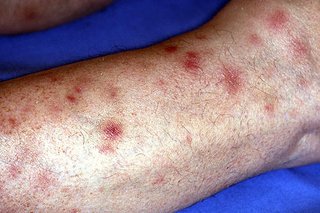Erythema nodosum is swollen fat under the skin causing red bumps and patches. It usually goes away by itself but it can be a sign of something serious.
Check if you've got erythema nodosum

DR P. MARAZZI/SCIENCE PHOTO LIBRARY

BSIP SA / Alamy Stock Photo

Hercules Robinson / Alamy Stock Photo
You may also have flu-like symptoms, such as:
- a high temperature of 38C or more
- tiredness
- joint and muscle pain
If you're not sure it's erythema nodosum
Check other types of lumps.
How you can ease the pain yourself
- take painkillers, like ibuprofen
- rest with your feet raised on a pillow
- apply a cool wet compress, like a damp cloth
The bumps and patches last about two weeks before fading like a bruise.
They usually heal completely on their own within six weeks without leaving a scar.
A pharmacist can help with erythema nodosum
If you're in pain, your pharmacist can recommend:
- stronger painkillers
- supportive bandages or stockings
- steroid creams
Your pharmacist may also suggest you see your GP.
Non-urgent advice: See a GP if:
- the pain is affecting your daily life
- lots of bumps and patches start appearing
- the bumps don't go away
Treatment from a GP
Your GP should be able to tell if you have erythema nodosum by looking at your bumps and patches.
If your GP thinks your medication might be causing your erythema nodosum, you may be advised to stop taking it. Don't stop taking your medication without asking your GP first.
You GP might suggest some tests if your erythema nodosum:
- could be a sign of something more serious
- hasn't cleared within six weeks
Causes of erythema nodosum
Erythema nodosum can be caused by lots of things but often the cause is not known.
Common causes include:
- Crohn's disease
- ulcerative colitis
- a bad reaction to some medicines
- sarcoidosis
- tuberculosis
- pneumonia
- streptococcal infection
Page last reviewed: 15 September 2017
Next review due: 15 September 2020
